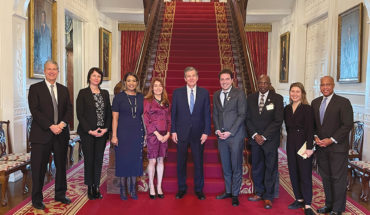by Scott Huler
photographs by Lissa Gotwals
Danielle Centeno tastes in shapes. Centeno, head chocolatier of Escazu Artisan Chocolate on North Blount Street, has synesthesia – a conflation of two senses – that causes her, when she eats, to experience not just taste but geometry and color. “This one is round,” she’ll say of a dark chocolate sweetened with goat’s milk. “It’s reddish – heavy, a little dirty, not too sharp; interesting and pretty.” Or, regarding one made with Costa Rican beans: “I always describe this one as green – green as the green forests after a rainfall and the earth is wet.”
Chances are you don’t taste in colors and shapes; chances are when you taste chocolate, your only thought is “more, please.” Fortunately, Centeno, 33, and other chocolatiers have sparked a chocolate boom that places Raleigh at the forefront of a burgeoning craft chocolate movement.
“Chocolate, coffee, beer, and wine are cousins,” says Starr Sink Ratto, co-owner of Videri Chocolate Factory, on West Davie Street in the warehouse district. “Love in equals love out.” In the past several years Escazu and Videri have both opened up eat-in chocolate stores where you can buy bars and confections and eat them at tables a few feet from where they were made, while enjoying a grown-up cup of coffee.
And you thought a chocolate bar was something a little kid jammed in her mouth and munched.
“A lot of people, when they sit down to eat chocolate, they just put it in their mouth and start chewing,” Centeno concedes, shaking her head. “Don’t do that.”
She allows a piece of 81-percent Carenero dark chocolate made from a single source of beans from Venezuela, dissolve in her mouth. She gets a faraway look in her eyes. Her lips purse, her jaw making the tiny, gentle circles that represent savoring. She asks you to do the same with an identical tiny piece she has placed on a plate for you. She asks you to identify the emerging flavors. “Uh,” you say. “Yum?”
“Tobacco is a note this chocolate tends to have,” she smiles. “Also cherry. Each batch is different – the last harvest was really tart and cherry; this one is lighter. Also it has a little banana flavor.” She shrugs. “That’s just to me.”
Don’t mistake the shrug for nonchalance. As co-creator of the first bean-to-bar chocolate manufacturer in the Southeast, Centeno she knows her stuff, and she wants to pass it on. She wants to invite you into the process of creating chocolate.
Escazu has put its melangeur – a vintage 1930s grinder with stone wheels from Spain – into a shop window, where it turns chunks of roasted beans, or cocoa nibs, into a rich, glistening goop called chocolate liquor. She wants you to see it’s a labor of love: Her partner, chocolate maker Hallot Parson, 43, keeps a bowl on hand to demonstrate what an average bag of beans gives up after they’ve hand-sorted out impurities: pounds of twigs, leaves, stones, and even pieces of metal. He’s also got a full cocoa pod and some beans, to show what they look like after fermenting.
He can walk you through the entire process – because he has lived it. A longtime chef, Parson was inspired to start making chocolate in 2005 when he met a farmer in Costa Rica growing beans and making the stuff. He reached out to Centeno, a Culinary Institute of America-trained chef he’d worked with in Texas. “Whether it could be done well as a business was still unknown,” Parson says of artisan chocolates. “There were not even models to follow.”
After “a lot of trial and error and a lot of money,” in 2008 they rented their first retail space on Glenwood South. Parson, who is from Apex, wanted to be closer to family, and Raleigh looked promising. As Escazu’s operation expanded, a year later they rented larger digs on North Blount near the Mordecai neighborhood, initially just for making chocolate. But the neighborhood was so friendly and local demand so strong that they moved their retail space into the building, too. It worked. Sales rose, and they’ve won Best of the Triangle awards for four years running.
 Escazu imports from various farms and brokers, choosing beans for specific flavors. Like grapes, beans can be earthy, fruity, floral – or vegetative, including those notes of tobacco. Parson and Centeno still visit the Costa Rican farmer (in the region of Escazu, naturally) who was Escazu’s inspiration, and who today lets them customize bean flavor and character by tweaking the fermenting process.
Escazu imports from various farms and brokers, choosing beans for specific flavors. Like grapes, beans can be earthy, fruity, floral – or vegetative, including those notes of tobacco. Parson and Centeno still visit the Costa Rican farmer (in the region of Escazu, naturally) who was Escazu’s inspiration, and who today lets them customize bean flavor and character by tweaking the fermenting process.
Escazu has earned that kind of clout: The company sold 70,000 chocolate bars and 100,000 confections last year. Parson is the bar guy; Centeno makes the truffles and other more complicated treats – and so it’s already outgrowing its Blount Street space. But moving isn’t certain – “It would have to be the place,” Centeno says. “We don’t want to leave these people.”
Let’s start a chocolate factory
At Videri Chocolate Factory on West Davie Street, they haven’t reached that level of connection to the source. “We wanted to make great chocolate first before we put on our safari hats,” says co-owner Sam Ratto, 33, who moved to Raleigh with his wife, Starr Sink Ratto, 36, in 2009 to be closer to her family in Winston-Salem. And they went to the right place to learn to make great chocolate: Both originally worked for Escazu.
In 2009, Sam, a former sports shoe company sales rep, started working at the chocolate pioneer and became excited about making chocolate on his own. He contacted Chris Heavener, whom he’d known in the action sports business, to help find investors. “The more I looked at it,” Heavener says from a table in the retrofitted lobby of Videri’s brick, industrial-age warehouse, “the more it looked like an exciting project to be part of.”
Tired of New York City life and looking for space to spread out “and raise some animals, grow some vegetables, raise a family,” says Heavener, 31, “these sort of converged into: Let’s move to Raleigh and start the chocolate factory.”
By then, the craft chocolate movement trail-blazed by Escazu had spread. “We crisscrossed the country looking at small-batch chocolatiers,” Heavener says, and learning from what they saw. And they came up with a plan that, though it starts with great chocolate, also emphasizes the customer experience.
“When people walk in,” he says, gesturing to the shelves packed with bars of Videri chocolate, “we want to show this abundance of chocolate that we have.” The Videri name echoes the state motto, Esse quam videri, or “to be rather than to seem.”
 Customers are invited to see every element of the chocolate-making process – from a window overlooking the table where employees sort beans, to a walk-through of the production area, where cocoa beans, cocoa butter, and sugar winnow, roast, and grind, releasing intoxicating aromas. Even the confectioner making truffles is on display behind a glass partition. After the free tour customers can buy the final product back in the lobby – and at 25 stores in Raleigh so far.
Customers are invited to see every element of the chocolate-making process – from a window overlooking the table where employees sort beans, to a walk-through of the production area, where cocoa beans, cocoa butter, and sugar winnow, roast, and grind, releasing intoxicating aromas. Even the confectioner making truffles is on display behind a glass partition. After the free tour customers can buy the final product back in the lobby – and at 25 stores in Raleigh so far.
There may have been a hint of friction between the original (Escazu) and this spinoff, but Parson is philosophical. “Competition is good,” he says. “One good restaurant in a town is good. Five good restaurants is a scene.”
Latest entrant
Dan Doren, principal with his wife Geraldine in GerDan Chocolates, perhaps Raleigh’s newest chocolatier, agrees that more is better. He has been a craft brewer for years, a veteran of the explosion in brew pubs. “The first guy to open up a brewery, when the second guy opens up, he gets pissed.” But over time, the more brew pubs, the more customers and everybody wins. Though GerDan has been in business only two years, it had its start about 15 years ago when the pair, now both 48, lived in San Diego, in the courtyard of an apartment complex they shared with plenty of caterers and restaurateurs. “We always had the ‘Speakeasies,’” Dan recalls, when everybody would trot out some food specialty or another and try to impress.
“But everybody kept saying they’d never do chocolate. Chocolate was too difficult and too temperamental for everybody.”
Dan loves a challenge. He had to learn the complex process of tempering – by which the temperature of the ground and solidified chocolate is raised, then lowered, then further manipulated to control the various crystals that form in the chocolate liquor – the glistening, oily mass created by the melangeur.
He has mostly felt his way along – “I knew the fat content, but I didn’t know all the molecular chemistry,” he laughs, showing off the GerDan tempering machine in the tiny warehouse workspace the two rent from an equally tiny winery in North Raleigh. “It’s two little light bulbs heating that up,” pipes in the Irish Geraldine, in a wry Dublin accent. “The temper is 99 percent of it,” says Dan. “When it’s right, it’s nice and shiny, and comes right out of the molds” he uses for his truffles. “And temper gives you that nice snap when you bite into it,” Geraldine adds. Those truffles are made of chocolate shells, often hand-painted (sometimes with cocoa-butter-loaded airbrushes) and filled with ganache made of chocolate, cream, and other raw ingredients like lime or liquor.
The two moved to Raleigh when Geraldine decided she’d spent enough time in San Diego, and the two researched cities. Raleigh showed up on every list, so they packed up and came. In 2012 they sold out their first batches, mostly to Geraldine’s coworkers. Since then they’ve constantly grown, selling at the North Hills farmer’s market and on their website, “and this year we’re picking up parties and baby showers.” They also make hand-rolled truffles – they’re dipped, having no molded shell – and ice creams and caramels. “The truth is, we’re going to get more famous for Geraldine’s caramels than for my chocolates,” Dan says.
Speaking of hand-rolled truffles, Steven Vagasky, called by one local chocolate maker “the godfather of Raleigh chocolate,” makes nothing but. He has been making it since 1985, when he moved to Raleigh the old-fashioned way: His girlfriend’s dad was moved here by IBM. Like Escazu’s Danielle Centeno, Vagasky, 56, is a graduate of the Culiniary Institute of America. He learned the art of chocolate making during an internship at the Greenbrier resort in West Virginia, where a friendly chocolate chef taught him old-fashioned methods – for example, tempering chocolate by manipulating it on a marble slab, and checking temperature with skin rather than thermometer. He explains how his hand-dipped truffles have a much thinner shell than molded ones – and won blue ribbons at the State Fair. “Until they said I couldn’t enter anymore.” He smiles. The category changed to exclude professionals, but Vagasky just figured he’d just won too much.
He spends most of his time catering out of the professional-grade kitchen in his Apex home, and he makes about 1,000 pounds of chocolates a year, available in one store or another or through his website. He could grow bigger, but he sees making truffles at a reasonable pace as something he can do forever. “I’m doing what I love.”
Another household professional grade kitchen supports Red Light Chocolates, started by Kirstin and Rob Neira in 2007 in response to crisis. Their daughter, Addy, was born 12 weeks prematurely, and when Kirstin, 36, left her at the neonatal intensive-care unit for the first time and called her boss, she learned she had been laid off. Unsurprisingly, that changed her opinion of a corporate job. She had always loved cooking and considered making “cake puffs,” also called cake truffles. That led her to chocolate truffles and a few kitchen experiments. “I fell in love with chocolate,” she says. “At the beginning, Rob was just the dishwasher.”
Classes at the Callebaut Chocolate Academy in Chicago led to enough success that the Neiras upgraded their Fuquay-Varina kitchen and started Red Light Chocolates, named for a red tool box with a light bulb in it they use to keep cocoa butter at the appropriate temperature. When they brought truffles to A Southern Season, they had an order within five minutes, and they’re now in Nofo at the Pig and other stores. Addy, by the way, is fine and often accompanies them to meetings or shows. And Rob, 42, now airbrushes the truffles – “and whoever gets done first does the dishes.”
So Raleigh fairly swells with first-rate artisanal chocolates, and we haven’t even mentioned WR Chocolatier, where Teresa Wilkerson, whose chocolates have been purchased by such places as Nofo and The Umstead, is on maternity leave with her 5-month-old.
The only question remaining is whether all this fine chocolate ruins us for the sugary, waxy classics – but no worries. “I will sometimes go to the store for M&Ms,” says Dan Doren. “I tell myself we can’t make the candy shell.” And Sam Ratto comforts all pragmatic chocolate lovers: “I’ve still got a Snickers in the freezer.”






